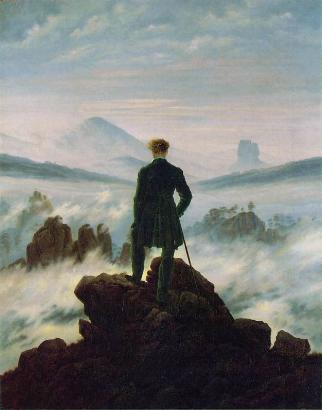|
|
Elements of Romanticsm
Caspar Friedrich's Wanderer in the Mists (1818) Fine Arts Museum, Hamburg |
Elements of Romanticsm Caspar Friedrich's Wanderer in the Mists
(1818) Fine Arts Museum, Hamburg

Gallery for Romanticism: click here
Lyrical Ballads: Wordsworth and Coleridge published this influential book in 1798. Know the influences of this book as well as its date!
Economics: Industrial revolution was underway. British, European and American cultures were changing from rural based agricultural economies to urban, industrial nations. Working conditions were appalling. For example, one of Lord Byron's first speeches in parliament supported the Luddites. Recall what we said about Ned Ludd in class.
Interest in the Common Man: Jacob and Wilhelm Grimm were brothers and German scholars. The brothers are considered the founders of Germanic philology as a systematic study. Among the works on which the Grimms collaborated are Deutsche Sagen (German Legends, 1816) and the famous collection Kinder und Hausmarchen (lit, Children's and Household Tales, also known as Grimm's Fairy-Tales, 1812. The brothers got most of their material from peasants whom they interviewed; Wilhelm, who tended more toward literary ciriticism and appreciation than his brother, did most of the transcription. Jacob, more the scholar, wrote Deutsche Grammatik (German Grammar, 1819, in which he formulated "Grimm's Law," the first attempt to explain the sonsonantal differences between Greek and Latin words and their cognates in the Germanic languages. It was also Jacob who did most of the work on the definitive Deutsches Worterbuch, (German Dictionary).
Political events: American Revolution; French Revolution; Lord Byron travels and dies in Greece while he tries to help the locals fight for independence.
Philosophy: Jean Jacques Rousseau (1712-1778) delineated the virtues of life in a state of nature, far removed from civilization. Rousseau's influential theories resulted in a cult of the "noble savage." Books were written about children being raised entirely in nature; writers and painters sentimentalized country scenes and country people; the American Indian, because they had not been "infected" with civilization, were conceived as models of humanity in a pure, natural state.
Mary Shelley's Frankenstein, 1818
Gothicism: Horace Walpole introduced the first Gothic novel in 1764 with The Castle of Otranto: A Gothic Story. Gothic novels were usually mysteries in which similar and sometimes supernatural events occurred and were ultimately caused by some evil human action. The language was frequently overly dramatic and inflated. Following this movement was the Romantic movement's fascination with the macabre and superstistious aspects of life, allowing them the freedom to explore the darkest depths of the human mind. Most critics agree that Mary Shelley's Frankenstein reflected her deepest psychological fears and insecurities, such as her inability to prevent her children's deaths, her distressed marriage to a man who showed no remorse for his daughters' death, and her feelings of inadequacy as a writer. The Gothic novel usually expresses, often in subtle and indirect ways, our repressed anxieties.
Other poems to read after Gray's Elegy Written in a Country Churchyard
See Also: Elegy Written with his own Hand in the Tower before his Execution
by Chidiock Tichborne (1568? -1586)*
My prime of youth is but a frost of cares,
My feast of joy is but a dish of pain,
My crop of corn is but a field of tares,
And all my good is but vain hope of gain:
The day is past, yet I saw no sun,
And now I live, and now my life is done.
My tale was heard, and yet it was not told,
My fruit is fall'n, yet my leaves are green,
My youth is spent, and yet I am not old,
I saw the world, and yet I was not seen:
My thread is ut, and yet it is not spun,
And now I live, and now my life is done.
I sought my death, and found it in my womb,
I looked for life, and saw it was a shade,
I trod the earth, and I knew it was my tomb,
And now I die, and now I was but made:
My glass is full, and now my glass is run,
And now I live, and now my life is done.
* Accused of taking part in the Babington Conspiracy, a plot by Roman Catholics against the life of Queen Elizabeth I, eighteen-year-old Tichborne was hanged, drawn, and quartered at the Tower of London. This is virtually all that is known of him.
Content for the above was copied and gleaned from a great teaching resourse: Poetry for Students, Volumes 1-12. Comp. and Ed. Elizabeth Thomason. Michigan: Gale Group, 1999.